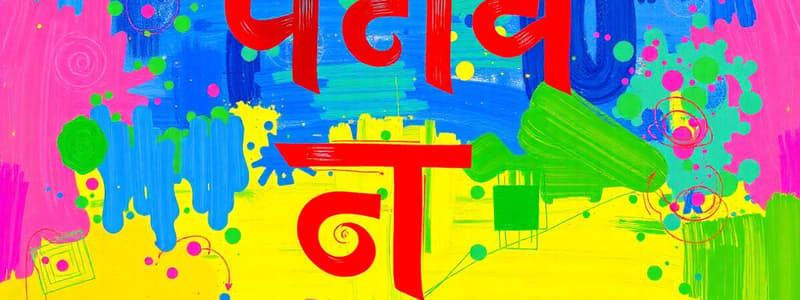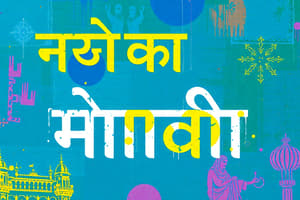Podcast
Questions and Answers
Which of the following best describes the relationship between Hindi and Hindustani?
Which of the following best describes the relationship between Hindi and Hindustani?
- Hindustani is the standardized form of Hindi used in government.
- Hindi is a standardized register of Hindustani, drawing heavily from Sanskrit. (correct)
- Hindustani is a dialect of Hindi with Persian and Arabic influences.
- Hindi is the older, less formal version of Hindustani.
The development of 'High Hindi' in the 19th century was primarily characterized by what?
The development of 'High Hindi' in the 19th century was primarily characterized by what?
- A move to simplify the language by removing Sanskrit vocabulary.
- An effort to create a unified language by combining Hindi and Urdu.
- Increased use of Persian and Arabic vocabulary to broaden its appeal.
- A conscious effort to differentiate itself from Urdu through Sanskritization. (correct)
Which of the following statements accurately describes the geographical distribution of Hindi speakers in India?
Which of the following statements accurately describes the geographical distribution of Hindi speakers in India?
- While concentrated in the 'Hindi Belt,' significant populations of Hindi speakers exist in other regions. (correct)
- Hindi speakers are exclusively located within the 'Hindi Belt'.
- Hindi is only spoken in rural areas; urban centers primarily use English.
- Hindi is primarily spoken in South India and is less common in the North.
In the context of official languages in India, what is the role of the Department of Official Language?
In the context of official languages in India, what is the role of the Department of Official Language?
Which characteristic of the Devanagari script is essential in understanding how Hindi words are written and pronounced?
Which characteristic of the Devanagari script is essential in understanding how Hindi words are written and pronounced?
How does the grammatical structure of Hindi generally organize a sentence?
How does the grammatical structure of Hindi generally organize a sentence?
In Hindi grammar, what is the function of postpositions, and how do they differ from prepositions in English?
In Hindi grammar, what is the function of postpositions, and how do they differ from prepositions in English?
Considering the influence of Sanskrit on Hindi, which aspect of the language has been most significantly shaped by Sanskrit?
Considering the influence of Sanskrit on Hindi, which aspect of the language has been most significantly shaped by Sanskrit?
Which of the following statements accurately describes the historical relationship between Hindi and Urdu?
Which of the following statements accurately describes the historical relationship between Hindi and Urdu?
What role does Sanskritization play in the development and characteristics of the Hindi language?
What role does Sanskritization play in the development and characteristics of the Hindi language?
Which of the following is the most accurate description of Hindustani?
Which of the following is the most accurate description of Hindustani?
In what way does Bollywood contribute to the Hindi language?
In what way does Bollywood contribute to the Hindi language?
What is a key grammatical feature that characterizes Hindi, distinguishing it from languages like English?
What is a key grammatical feature that characterizes Hindi, distinguishing it from languages like English?
Why has the promotion of Hindi as an official language in India been a subject of debate and controversy?
Why has the promotion of Hindi as an official language in India been a subject of debate and controversy?
Which of the following best describes the relationship between standard Hindi and its dialects?
Which of the following best describes the relationship between standard Hindi and its dialects?
What is the significance of gendered nouns in Hindi grammar?
What is the significance of gendered nouns in Hindi grammar?
Which of the following factors contributes most to the increasing acceptance and visibility of Hindi in global contexts?
Which of the following factors contributes most to the increasing acceptance and visibility of Hindi in global contexts?
How does the use of postpositions in Hindi affect sentence structure, compared to languages that use prepositions?
How does the use of postpositions in Hindi affect sentence structure, compared to languages that use prepositions?
Flashcards
What is Hindi?
What is Hindi?
An Indo-Aryan language, official language of the Union government of India, and one of the 22 scheduled languages of India.
What is 'High Hindi'?
What is 'High Hindi'?
A standardized and Sanskritized register of the Hindustani language, based on the Khariboli dialect.
Ancestor of Hindi?
Ancestor of Hindi?
Vedic Sanskrit evolved through Prakrit and Apabhramsa languages.
What is the 'Hindi Belt'?
What is the 'Hindi Belt'?
Signup and view all the flashcards
Official Languages of the Union Government of India?
Official Languages of the Union Government of India?
Signup and view all the flashcards
What is the Devanagari script?
What is the Devanagari script?
Signup and view all the flashcards
Typical Hindi word order?
Typical Hindi word order?
Signup and view all the flashcards
Vocabulary of Hindi is mainly from what language?
Vocabulary of Hindi is mainly from what language?
Signup and view all the flashcards
Sanskritization
Sanskritization
Signup and view all the flashcards
Hindustani
Hindustani
Signup and view all the flashcards
Devanagari
Devanagari
Signup and view all the flashcards
Bollywood
Bollywood
Signup and view all the flashcards
Khariboli
Khariboli
Signup and view all the flashcards
Agglutinative Language
Agglutinative Language
Signup and view all the flashcards
Gendered Nouns
Gendered Nouns
Signup and view all the flashcards
Postpositions
Postpositions
Signup and view all the flashcards
Hindi and Urdu
Hindi and Urdu
Signup and view all the flashcards
Link Language
Link Language
Signup and view all the flashcards
Study Notes
- Indo-Aryan language spoken chiefly in India
- The official language of the Union government of India
- One of the 22 scheduled languages of India
- Often described as a standardized and Sanskritized register of the Hindustani language
- Hindustani is based on the Khariboli dialect of Delhi and neighboring areas
Origin and History
- The ancestor of Hindi is considered to be Vedic Sanskrit.
- It evolved through Prakrit and Apabhramsa languages.
- By the 13th century, the Khariboli dialect emerged as the basis for Hindustani.
- During the Mughal period, Hindustani became a lingua franca.
- In the 19th century, efforts were made to standardize Hindi, drawing heavily from Sanskrit for vocabulary.
- "High Hindi" was promoted as a distinct language from Urdu, which drew vocabulary from Persian and Arabic.
Geographical Distribution
- Spoken in the "Hindi Belt" of India
- Includes states like Uttar Pradesh, Madhya Pradesh, Bihar, Haryana, Rajasthan, Himachal Pradesh, Uttarakhand, Chhattisgarh, and Jharkhand
- Significant populations of Hindi speakers are also found in other parts of India, such as Delhi and Maharashtra
- Spoken to varying degrees by over 500 million people
Official Status
- The official language of the Union government of India alongside English
- Many states within India have declared Hindi as one of their official languages
- The promotion and development of Hindi are overseen by the Department of Official Language
Writing System
- Written in the Devanagari script
- Devanagari is an abugida script, where each consonant has an inherent vowel
- Vowels can be written as independent letters or as diacritics modifying consonants
- The script is written from left to right
Structure and Grammar
- Largely based on Sanskrit grammar
- Exhibits a subject-object-verb (SOV) word order
- Uses postpositions instead of prepositions
- Nouns are inflected for gender (masculine and feminine) and number (singular and plural)
- Verbs are inflected for tense, aspect, mood, gender, and number
- Employs a system of verb conjugations based on these categories
- Three main tenses: past, present, and future
- Aspect indicates the completeness or duration of an action
- Mood expresses the speaker's attitude toward the action
- Agreement between the subject and verb is essential
Vocabulary
- Primarily derived from Sanskrit
- Also includes loanwords from Prakrit, Persian, Arabic, English, and Portuguese
- The process of Sanskritization has led to the adoption of numerous Sanskrit terms
- Helped to create a formal and standardized vocabulary
- Everyday Hindi uses simpler words derived from Prakrit and local dialects
Influence and Relationship to Urdu
- Share a common origin in the Hindustani language
- At a colloquial level, Hindi and Urdu are mutually intelligible
- The primary differences lie in the formal vocabulary and writing system
- Hindi draws heavily from Sanskrit, while Urdu draws from Persian and Arabic
- Hindi is written in Devanagari, and Urdu is written in the Perso-Arabic script
- The divergence between Hindi and Urdu was promoted during the colonial period
- This divergence was often along religious lines, with Hindi associated with Hinduism and Urdu with Islam
- Despite the differences, the shared core of Hindustani remains a testament to their common linguistic heritage
Dialects
- Numerous dialects and regional variations exist
- These dialects can differ significantly in vocabulary, grammar, and pronunciation
- Some of the prominent dialects include: Khariboli, Braj Bhasha, Awadhi, Bhojpuri, Bundeli, Bagheli, and Haryanvi
- Khariboli is the basis for standard Hindi
- Braj Bhasha was historically important in literature
- Awadhi has a rich literary tradition
- Bhojpuri is spoken in eastern Uttar Pradesh and Bihar
Literature
- Has a rich and diverse history
- Early Hindi literature includes religious and devotional poetry
- The Bhakti movement produced important works in various Hindi dialects
- Modern Hindi literature encompasses a wide range of genres, including novels, short stories, plays, and essays
- Prominent Hindi writers include: Premchand, Jaishankar Prasad, Suryakant Tripathi 'Nirala', Mahadevi Varma, and Harivansh Rai Bachchan
Cinema
- Hindi cinema, also known as Bollywood, is a major cultural force in India
- Produces a large number of films each year, which are popular both in India and abroad
- Hindi film songs are an integral part of Indian culture
- Bollywood has played a significant role in promoting the Hindi language
Role in Indian Society
- Serves as a link language in many parts of India
- Used in education, administration, media, and entertainment
- The promotion of Hindi has been a subject of debate and controversy in India
- Concerns about linguistic imperialism have been raised by speakers of other languages
Learning Hindi
- Taught as a subject in schools across India
- Offered as a language of study in universities around the world
- Numerous resources are available, including textbooks, online courses, and language exchange partners
Hindi vs Hindustani
- Hindustani is the lingua franca of northern India and Pakistan
- Hindi and Urdu are standardized registers of Hindustani
- Hindustani is a more colloquial and inclusive term
- Hindi adheres to a more Sanskritized vocabulary
- Urdu adheres to a more Perso-Arabic vocabulary
- Hindustani is often used in Bollywood films
Key Features of Hindi
- Agglutinative Language: Suffixes are extensively used to denote grammatical relations
- Gendered Nouns: Nouns are either masculine or feminine, influencing verb agreement and adjective usage
- Postpositions: Uses postpositions instead of prepositions to indicate relationships between words
Modern Trends
- Growing use of Hindi on the internet and social media.
- Increasing acceptance and visibility of Hindi in global contexts.
- Continued efforts to promote Hindi as an official language.
- Ongoing debates regarding the role and status of Hindi in a multilingual India.
Studying That Suits You
Use AI to generate personalized quizzes and flashcards to suit your learning preferences.




